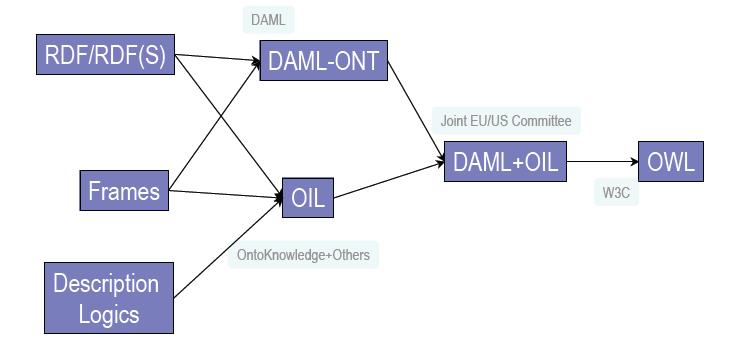OWL (Web Ontology Language) is the standard ontology language for semantic web recommended by World Wide Web Consortium (W3C) in 2004. This language extends RDF and RDF-S, two early standard languages for semantic web, by adding more features on vocabulary terms. OWL has a valid syntax as RDF document and well-formed XML document. The diagram of family tree shows that OWL was developed based on DAML (The DARPA Agent Markup Language) + OIL (Ontology Inference Layer). The U.S. Defense Department and European Defense community combined DAML and OIL as a web ontology language in order to find the dynamic data format that can be used by intelligent agents to understand autonomously on that data. Further, W3C used OWL as a standard ontology language because it can integrate RDF and RDFS as well as other web semantic standards that cannot be done by DAML+OIL.
The Species of OWL
There are 3 variants sublanguages of OWL endorsed by W3C:
- OWL Lite
OWL Lite was designed to support users that need a classification hierarchy and simple constraint features. For example, while it supports cardinality constraints, it only permits cardinality values of 0 or 1. It should be simpler to provide tool support for OWL Lite than its more expressive relatives, and provide a quick migration path for thesauri and other taxonomies.
- OWL DL
OWL DL was designed to supports users who want the maximum expressiveness by taking into consideration the factor of computational completeness and decidability of reasoning systems. OWL DL includes all OWL language constructs, but in order to use it, users must consider about the restrictions such as type separation (a class can not also be an individual or property, and vice versa). OWL DL is so named due to its correspondence with description logic, a field of research that has studied the logics that develop the basic foundation of OWL.
- OWL Full
OWL Full was designed to provide the maximum expressiveness and compatibility for RDF schema, based on different format of OWL Lite or OWL DL. For example, in OWL Full a class can be treated simultaneously as a collection of individuals and as an individual in its own right. OWL Full allows an ontology to augment the meaning of the pre-defined (RDF or OWL) vocabulary.
References:
- An Introduction to OWL. Sean Bechhofer. School of Computer Science. University of Manchester, UK (http://kmi.open.ac.uk/events/iswc08-semantic-web-intro/slides/02%20-%20Sean.pdf)
- W3C – OWL Web Ontology Language Guide (http://www.w3.org/Consortium/Legal/2002/copyright-documents-20021231)
- Jeffrey T. Pollock, Semantic Web For Dummies, For Dummies, 2009 (http://dl.acm.org/citation.cfm?id=1593457)
- http://en.wikipedia.org/wiki/Web_Ontology_Language
